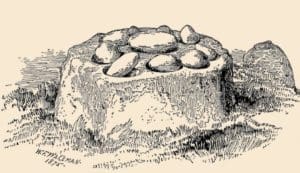The Craft of Irish Linen in Folklore: Unveiling its Mystical Heritage

Updated On: April 21, 2024 by Maha Yassin
Irish linen’s legacy intertwines with the cultural fabric of Ireland, telling a story that stretches back through the ages. This natural fibre, renowned for its quality and strength, has been deeply rooted in Irish folklore and tradition. The craft of Irish linen is a testament to the skill and craftsmanship that has been passed down through generations, weaving together tales of domestic life and the broader narrative of Ireland’s social and economic evolution.
The production of linen in Ireland has long been more than just a means of creating fabric; it has been a symbolic thread in the tapestry of Irish identity. Transforming the flax plant into the fine cloth known as linen is an art that has evolved over millennia. From the fields where the flax is grown to the hands of the weavers at the loom, every step in the creation of linen is steeped in history and heritage. The intricate patterns and designs that adorn Irish linen reflect a culture that values aesthetics as much as practicality
Historical Evolution of Irish Linen

Our exploration of the craft of Irish linen uncovers a rich tapestry woven through time, where economic significance and skilled craftsmanship intertwine. The narrative of Irish linen is steeped in a journey of cultural exchange, technological innovation, and regional pride, particularly within the communities that championed its production.
Early Beginnings and the Flax Plant
The cradle of Irish linen is rooted in the dewy fields where flax, the bedrock of linen fabric, thrived. Cultivated across Ireland around 5000 BC, flax was historically processed by hand through laborious techniques, ensuring its fibres could be spun into high-quality yarns. The early production methods, while rudimentary, laid the foundation for a flourishing linen industry.
The Role of the Huguenots
Our linen narrative blossoms further with the arrival of the Huguenots. This skilled group of French Protestants, seeking refuge after 1685, brought advanced weaving and finishing techniques that significantly enriched local linen production. Notably, their arrival heralded an era of craftsmanship and quality that would become synonymous with Irish linen, elevating it to a commodity of international repute.
The Linen Homelands: Lisburn and Beyond
Finally, we turn to the heartlands of the linen industry. With its notable Huguenot influence, Lisburn emerged as a linen stronghold, setting a precedent for other towns across Northern Ireland to follow. Throughout the 19th Century, these hubs were at the centre of a thriving economic landscape, harnessing the power of the Industrial Revolution to expand their reach and drive innovation within the sector.
The Linen Craft Process

The creation of Irish linen is a testament to the skill and tradition of textile craftsmanship. This section’ll unravel the intricate methods of transforming the humble flax plant into the esteemed fabric gracing our homes and wardrobes.
Raw Material: From Flax to Fibres
Flax is the backbone of linen, a blue-flowered crop harvested mainly for its fibres. Once we’ve gathered the flax, the retting process begins, which is crucial for separating the fibres. This involves soaking the stalks to break down the pith holding the fibres together. Careful timing is essential; if flax is retted too long, the fibre quality degrades, while under-retting makes fibre separation difficult.
Spinning: The Art of Yarn Creation
After retting, fibres are dried, combed and then spun, transforming them into yarn. Spinning is a craft, where fibre is drawn out and twisted, strengthening the thread. From hand-spinning to industrial methods, the expertise weaves tradition’s strands with modernity.
Weaving: Merging Skill and Tradition
Finally, weaving takes our spun yarn and turns it into linen cloth. This stage is where the magic of linen fabrication truly comes to life through the rhythmic interlacing of yarn. The weaver’s loom executes a dance between the weft and warp threads, blending centuries-old techniques and the accumulated knowledge of generations. Our weavers maintain a steady hand and keen eye to ensure each piece of linen meets the high standards set by Irish folklore and history.
Looms and Weavers
In the tapestry of Irish linen, the weaver and the loom interlace to create fabric steeped in cultural significance. This section homes in on the deft hands of the artisans, and the heirloom looms central to the weaving process.
The Weaver’s Role in Linen Production
With their seasoned skills, weavers are pivotal to linen production, transforming flax into finely woven fabric. The craft demands precision and a nuanced understanding of the loom’s rhythm. In Ireland’s folklore, the figure of the weaver often emerges as a bastion of tradition, steadfastly preserving the art form against the tide of industrialisation. Each artisan brings their personal touch to the fabric, making it a unique piece of Irish heritage.
Types of Looms Used in Irish Linen Weaving
A spectrum of looms exists, ranging from the simple handloom to the more complex flying shuttle loom, which took centre stage during the Industrial Revolution. The handloom, often wood-crafted, is a testament to the bespoke nature of early linen weaving. With the Industrial Revolution, the flying shuttle loom allowed for wider textile production and faster weaving, positioning Irish linen on the world stage. Despite these innovations, the handloom remains a cherished emblem, capturing the essence of individual weaver’s artistry.
Patterns and Designs

In Irish linen, patterns and designs are not just embellishments but a testament to the artistry and history embedded in the craft.
Damask Linen: The Luxury Fabric
Damask linen is recognised for its intricate patterns woven into a single fabric, rendering it both reversible and luxurious. Traditionally, these patterns feature florals and scrolls reminiscent of Irish folklore. The technique of weaving damask utilises a combination of plain and satin weaves, which allows light to play on the surface, thereby highlighting the design. The prominence of the damask tablecloth as a statement piece in fine dining settings speaks to the material’s high regard in the world of textiles.
Design Innovation: Jacquard’s Influence
The introduction of the Jacquard loom in the early 19th century revolutionised the production of patterned linen by automating the once manually intensive process. This innovation greatly expanded the possibilities for design complexity in Irish linen. The Jacquard loom allowed for the creation of elaborate patterns with precision, elevating the craftsmanship to new heights and transforming linen into a canvas for artistic expression. The loom’s impact on the industry is immeasurable, establishing new standards for design innovation in the craft.
Irish Linen in Domestic Use

Irish linen has long been esteemed for its quality and beauty, leading to widespread use in homes throughout Ireland and beyond. Let us explore its role in two specific areas: at the dining table and within interior design.
Linen at the Dining Table
In many households, the dining table is the heart of home life, witness to family gatherings and festive celebrations. Tablecloths and napkins made from Irish linen are prized possessions, often passed down through generations. The use of linen tablecloths dates back to when displaying a fine weave and intricate patterns symbolised hospitality and social standing. Linen napkins are not just practical items for maintaining cleanliness but also add a touch of luxury to the dining experience with their lustrous finish and substantial feel.
- Tablecloths: Luxuriously woven, often featuring delicate embroidery or lace.
- Napkins: Durable and soft, with the ability to hold crisp folds.
Linen and Interior Design
Irish linen’s versatility extends to home décor, where its natural, lustrous quality adds an understated elegance. As a premium textile, it lends itself to various home decor applications, including draperies, cushion covers, and upholstery. The fabric’s durability and the graceful way it drapes make it a popular choice for adding a layer of finesse to any room. Additionally, pure linen in a neutral palette or with gentle patterning can complement many interior design schemes, enhancing the overall aesthetic without overpowering it.
- Home Decor: Utilised for curtains, upholstery, and decorative accents.
- Curtain Drapery: Appreciated for its natural sheen and fluid drape.
Cultural Significance
In our exploration of Irish linen, we uncover its profound implications within the cultural fabric of Ireland. This textile is more than a mere material; it’s woven into the folklore and customs that define Irish heritage.
Irish Linen in Rituals and Celebrations
Irish linen has long been integrated into our rituals and celebrations, symbolising purity and good fortune. Its presence in Irish traditions is often seen in the use of handkerchiefs, particularly during weddings, where it’s thought to bring blessings to the newlyweds. Moreover, the custom of wearing linen by participants in the annual St. Patrick’s Day festivities pays homage to St. Patrick himself, reflecting our reverence for this aspect of Irish heritage.
Folklore and Mythology
The fabric’s role in folklore and mythology further underscores its cultural importance. Irish linen is frequently mentioned in tales and proverbs, signifying its status as a celebrated symbol of our national identity. The narratives often imbue the material with mystical qualities, making it central to stories passed down through generations. It’s a testament to the inextricable link between the craft of Irish linen and the rich tapestry of Irish lore.
Industrialisation and Linen

In this section, we’ll explore the significant milestones during the transition of Irish linen from handcraft to industrial manufacturing and its subsequent effects on the Irish economy.
Transition to Industrial Manufacturing
The craft of Irish linen underwent a fundamental transformation with the advent of industrial manufacturing. The late 17th century saw the arrival of Huguenot refugees who injected fresh vitality into textile production in Ireland. They introduced advanced weaving techniques, which marked the beginning of the industry’s modernisation. By the 18th century, mechanisation replaced manual labour with inventions like the spinning jenny and power loom. These technologies significantly increased production capacity, transforming linen into a leading industrial sector.
Effects on the Irish Economy
The economic impact of industrialisation in the linen sector was profound. This epoch marked a transition from agriculture-dominated employment to industrial jobs in linen mills and factories. During the 19th century, Belfast transformed into “Linenopolis,” serving as a global hub for linen production. Employment in the industry soared, which led to urbanisation and the establishment of a wealthier middle class. As production costs fell and output grew, Ireland positioned itself as a major exporter of linen, bolstering its economy and international trade relationships.
Contemporary Linen Industry

The Irish linen industry has transformed significantly, embracing modern production techniques and establishing a unique position in today’s global market.
Modern Production Techniques
We’ve witnessed remarkable advancements in the manufacturing processes of Irish linen. These include automated spinning and weaving, substantially increasing efficiency and output. Computer-aided design (CAD) systems now enable intricate patterns to be created with precision. Despite these technological improvements, the quality and feel of the linen remain rooted in the traditional methods passed down through generations.
Ireland’s Place in Today’s Linen Market
Our industry holds a significant niche in the global market. While countries like China and India lead in volume, Irish linen is renowned for its superior quality and is often associated with luxury products. We blend traditional craft and modern elegance, which resonates with discerning customers and designers worldwide. This synergy of heritage and innovation cement Ireland’s esteemed place in the international linen landscape.
Environmental Considerations

In crafting Irish linen, environmental stewardship is integral. We focus particularly on the fibre’s eco-friendly attributes and the water conservation efforts in its production.
The Eco-Friendly Nature of Linen
Linen is celebrated for its sustainability. The flax plant, from which linen fibres are derived, requires fewer pesticides and fertilisers than conventional crops like cotton. This leads to a diminished environmental footprint. Additionally, every part of the plant is utilised, meaning there’s minimal waste during the production of linen, making it an environmentally considerate choice for textiles.
Water Conservation in Linen Production
Water usage is a critical concern in fabric production. Linen’s production process is water-efficient, using significantly less water than cotton. Flax grows naturally in rain-fed conditions, reducing reliance on artificial irrigation systems. This water conservation aspect is paramount in our sustained commitment to eco-friendly practices. It ensures that linen production exerts minimal strain on our water resources and aligns with broader environmental sustainability goals.
Irish Linen Guild and Trademarks

The Irish Linen Guild serves as a bastion for preserving the esteemed craft of Irish Linen, with trademarks signifying the authenticity and quality inherent in these textiles.
Role of the Irish Linen Guild
The Irish Linen Guild plays a pivotal role in the world of Irish crafts, especially in promoting and preserving Irish linen. As a body founded in 1928, our main objective is safeguarding and advancing the linen’s reputation in Ireland. This means we’re continually championing Irish linen nationally and internationally, highlighting its unique qualities rooted in Irish heritage.
Trademarking and the Assurance of Authenticity
To ensure customers receive genuine Irish linen, the Guild has introduced a trademark—often referred to colloquially as the ‘carpet beater symbol’. This emblem guarantees the quality and provenance of the linen bearing it, serving as a seal of authenticity and quality assurance. We understand the importance of protecting this hallmark as it assures customers that they are buying not just linen but a piece of Irish legacy distinguished by its craftsmanship and history.
Linen Beyond Clothing

Linen’s versatility extends beyond its well-known use in clothing, reaching into areas of artistic and cultural significance in Ireland. The fabric serves not only as attire but also as a medium for various Irish crafts that resonate with tradition and creativity.
Artistic Expressions in Linen
We see the elegance of Irish Lace as it intricately weaves a narrative of skill and detail. Originally developed to mimic expensive Venetian lace, this craft became a staple in Irish heritage, transforming simple linen threads into breathtaking patterns and designs. One cannot discuss linen in Irish artistry without mentioning lace, such as that from the town of Carrickmacross, where the fusion of linen and lace-making exemplifies a storied craftsmanship passed down through generations.
Diversity of Irish Artisanal Crafts
In the same breath, we talk about crafts beyond textiles, acknowledging that the artistry in Ireland extends into Handwoven Tweed, another testament to the dexterity of Irish hands. Born from the rugged landscape of regions like Donegal, where each pattern tells a tale, the durable yet soft fabric is steeped in local history.
Equally impressive, Ireland’s Pottery scene showcases the delicate balance between strength and finesse. The potters’ wheels spin tales as old as time, moulding the very earth into vessels steeped in both utilitarian and aesthetic purposes.
Not to forget, the Connemara Marble Carving stands as a cornerstone of Irish craftsmanship. Sought after for its unique green colour, Irish artisans have sculpted this marble for generations. Each piece of Connemara marble carries Irish history, incredibly distinct and deeply rooted in the natural beauty of Ireland’s landscapes.

Frequently Asked Questions
This section covers some of the most common curiosities about the craft of Irish linen. These questions touch upon its traditional production, unique qualities, cultural importance, industry evolution, contemporary uses, and where it can still be sourced today.
How is Irish linen traditionally made?
Irish linen starts with cultivating flax plants, which are processed to extract fine fibres. These fibres are then spun into yarn and woven into linen fabric using methods that have been refined over centuries.
What distinguishes Irish linen from other types of linen?
Irish linen is esteemed for its exceptional quality, which stems from the expertise of Irish craftspeople and the ideal damp climate of Ireland, which is favourable for processing flax fibres. This produces linen with a distinctive texture that is both soft and long-lasting.
What historical significance does linen hold in Irish culture?
Linen has been integral to Irish culture for generations. The establishment of organisations like the Irish Linen Board in the 18th century to regulate the industry underscores its importance. Linen was a domestic staple and an essential export that played a key role in the economy.
How has the Irish linen industry evolved over the years?
The Irish linen industry evolved from a home-based, handcrafted tradition to an industrial powerhouse in the global textile market. Despite machinery advancements and the shift to factory-based production, traditional methods have preserved the quality that Irish linen is celebrated for.
What are the primary uses of Irish linen today?
Today, Irish linen is primarily used for luxury clothing, tableware, and bed linens, cherished for its natural lustre and ability to remain cool and fresh. Designers and high-end retailers continue to prize it for its superior quality and feel.
Is genuine Irish linen still produced, and where can it be obtained?
Yes, genuine Irish linen is still produced and can be found at specialist craft shops and certain online retailers. True connoisseurs seek it out for its authenticity and unrivalled craftsmanship.






